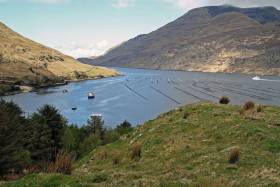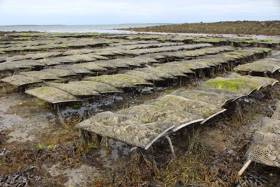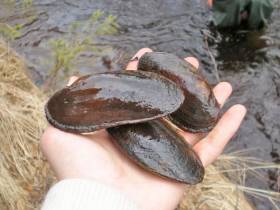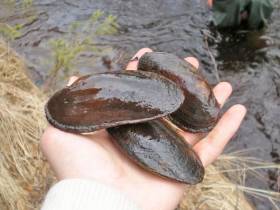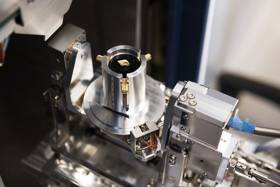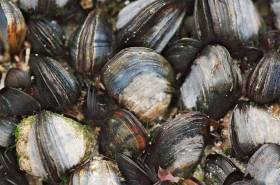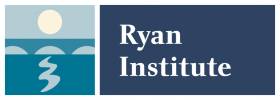Displaying items by tag: shellfish
New Research On Improving Biotoxin Monitoring In Shellfish
A postgraduate researcher is investigating the biotoxin production potential of Azadinium and related species in Irish waters, particularly in estuaries used for shellfish aquaculture such as Killary Harbour and Bantry Bay.
Stephen McGirr — a PhD candidate at the Institute of Technology Sligo and a Cullen Fellow at the Marine Institute — is studying Azadinium, a planktonic single-celled plant that lives in marine waters around Ireland.
Under certain conditions, Azadinium produces biotoxins which can build up in shellfish that feed on them. If eaten by humans, this can lead to shellfish poisoning.
Understanding more about the biology of this species would help both the shellfish aquaculture industry and protect human health.
“The genus Azadinium was first linked to incidents of shellfish poisoning in the 1990s and both toxic and non-toxic forms of the Azadinium species have since been identified in Irish waters,” McGirr says.
“More knowledge of the biology of the species is needed to support monitoring efforts currently underway to assist the aquaculture industry.”
Ireland’s aquaculture industry employed 1,925 people on 288 aquaculture production units, according to Bord Iascaigh Mhara’s Business of Seafood Report 2018. In 2018 it is estimated that Ireland produced 24,200 tonnes of farmed shellfish valued at €56 million.
“Aquaculture is a valuable industry to our national economy as well as for many of Ireland's coastal communities,” McGirr adds.
“The closure of aquaculture production sites due to biotoxins produced by organisms such as Azadinium impacts the industry and can also be detrimental to local economies.”
Stephen’s research supports the Marine Institute's National Phytoplanton Monitoring Programme, which monitors phytoplankton populations and dynamics around the Irish coastline.
‘Aquaculture is a valuable industry to our national economy as well as for many of Ireland's coastal communities’
McGirr says the Marine Institute’s Cullen Fellowship Programme is giving him the opportunity to learn and develop his skillset, working alongside scientists who are experts in their field, as well as gaining hands-on experience using state-of-the art equipment in the Institute's laboratories.
“I have joined two surveys on the RV Celtic Voyager along the south and western coastline of Ireland to collect both water column and sediment samples for our analyses.
“I have also presented my research at international conferences, including the International Conference on Molluscan Shellfish Safety held in Galway and the International Conference on Harmful Algae, held in Nantes, France.”
McGirr is currently focusing his efforts on translating the product of his research into articles for peer-reviewed scientific journals. His research supervisors are Joe Silke, Marine Institute and Dr Nicolas Touzet, IT Sligo.
The Cullen Fellowship Programme builds marine research capacity and capability by equipping graduates with the skills and expertise in raising awareness about our ocean, as well as Ireland's rich marine biodiversity and ecosystems.
The programme has provided grant aid to the value of €2.06 million supporting 24 PhD and three MSc students over the last five years. The research addresses a number of the 15 research themes identified in the National Marine Research and Innovation Strategy 2017-2021.
This project (Grant-Aid Agreement No CF/15/01) is carried out with the support of the Marine Institute and funded under the Marine Research Programme by the Irish Government.
Workshop Hears Latest Research On Shellfish Safety
More than 90 shellfish producers and processors, scientists, agencies and stakeholders attended the 11th Shellfish Safety Workshop earlier this month to discuss the latest advances in the field in Ireland.
The workshop, which took place on Tuesday 8 October in the Radisson Blu Hotel Athlone, was hosted by the Marine Institute and co-sponsors Food Safety Authority of Ireland, Sea Fisheries Protection Authority and Bord Iascaigh Mhara.
The event offered an opportunity to exchange information on the latest research and information on the cause and control of shellfish products harvested and farmed around Ireland's coast.
Speakers included Dr Conor Graham, of GMIT Marine and the Freshwater Research Centre, on the development of the world’s first scientific-based shellfish traceability tool, as previously reported on Afloat.ie.
Other speakers included Dr Monika Dhanji Rapkova, of the Centre for Environment, Fisheries and Aquaculture Science, on the learnings on regulated and emerging biotoxins in British shellfish.
Dr Eileen Bresnan (Marine Scotland Science) presented a talk on the regional distribution of harmful algal events in North Atlantic Area. Dave Clarke of the Marine Institute also talked about the insights and perspectives on monitoring algal and biotoxin events in Irish coastal waters from the past 20 years.
Micheál O'Mahony of the Sea Fisheries Protection Authority presented on the recently published European baseline survey of norovirus in oysters, while Dr Sinéad Keaveney (Marine Institute) discussed the survey in the Irish context.
There were also a series of flash presentations from representatives of the Marine Institute, Bord Iascaigh Mhara, Sea Fisheries Protection Authority, Food Safety Authority of Ireland, Dublin City University, Sligo Institute of Technology and Health Services Executive.
The proceedings of the workshop are currently being compiled for publication and in the coming weeks will be available for download from the Marine Institute’s Open Access Repository.
Studies carried out by a research team led by Galway-Mayo Institute of Technology (GMIT) have resulted in the development of the world's first scientific-based shellfish traceability tool.
This unique tool used ‘trace elemental fingerprinting’ of shellfish soft tissues and shells to identify the harvest location of blue mussels and king scallops with a 100% success rate — including mussels reared from two sites located just 6km apart within the one bay.
The technique used not only correctly identified the site of harvest of scallops, but was also able to distinguish between harvesting events just six weeks apart, both with 100% success.
The Marine Institute provided scientific advice and input into the initial stages of the research project, as well as providing samples of mussels and scallops for the studies led by Dr Conor Graham of the GMIT Marine and Freshwater Research Centre in collaboration with Dr Liam Morrison of Earth and Ocean Sciences and the Ryan Institute, NUI Galway.
The research was also conducted in association with the Food Safety Authority of Ireland, European Food Safety Authority and University College Dublin.
Lead scientist Dr Graham said: “In recent years consumers have become more food-conscious, seeking traceability of produce, and while such tools exist for agriculture, until now no scientifically based system existed to trace both farmed and wild shellfish produce to their source.
“The aquaculture of shellfish such as mussels and oysters and the wild fisheries for scallops, razorfish and clams is a multi-million industry in Ireland supporting thousands of jobs in rural maritime communities around our coasts. This research aimed to create the world’s first bivalve shellfish scientifically based traceability tool for Irish produce to promote this ecologically sustainable food.”
Trace elemental fingerprinting is somewhat similar to genetic analyses, the Marine Institute explains, except that instead of identifying the variation in a number of genes to create a unique genetic identifier, it analyses how large numbers of trace elements contained naturally within the flesh and shells of shellfish vary uniquely according to growing sites.
Although the shells of mussels and scallops are composed primarily of calcium carbonate, other elements are incorporated into their shells at relatively low levels as they grow, which is determined by the bioavailable concentrations of these elements in the surrounding water column in which the shellfish live.
The research was recently published in two scientific papers (on king scallops and blue mussels, respectively) in international peer-reviewed journal Science of the Total Environment.
Details will also be presented by Dr Graham at the Marine Institute’s 11th Shellfish Safety Workshop next Tuesday 8 October at the Radisson Blu Hotel in Athlone. The event will include presentations from representatives from a variety of state agencies, academic and research institutions and the shellfish industry.
The Marine Institute is the national reference laboratory in Ireland for the monitoring of marine biotoxins and microbiological/viral contamination of bivalve shellfish, and provides this information to the competent authorities under legislative and statutory requirements.
Projects for pearl mussels and conservation of breeding curlew are among the 23 schemes being carried out nationwide under the European Innovation Partnership (EIP), as highlighted in a new exhibition in Dublin.
Agriculture House on Kildare Street is currently showcasing the innovation under the Department of Agriculture, Food and Marine’s EIP/locally led schemes in Ireland.
Speaking at the launch yesterday (Wednesday 17 April), Marine Minister Michael Creed said: “We are committed to building a sustainable agricultural system that respects the environment. The agriculture sector is determined to play its part in responding to the challenges before us on climate, water quality and biodiversity.
“We are investing €59m in these locally-led schemes to achieve these goals at a local level by stimulating and developing innovative new approaches to tackling environmental challenges in a targeted way. This targeted approach to specific challenges in specific areas can complement our larger national agri-environmental schemes.”
The exhibition highlights the varied works undertaken by the EIP Project groups including projects on biodiversity, organic production, pollinators, water quality, flood management, soils, farming in an archaeological landscape and targeting un-utilised agricultural biomass.
The exhibition is open to the public to visit before going nationwide to other DAFM offices for display there. Following its display in Dublin, the exhibition will be moving to the department’s office at Johnstown Castle Estate in Wexford.
Further details of the EIP and locally led schemes can be found on the DAFM website HERE.
#Mussels - Marine Minister Michael Creed has announced the selection of a project team to run the new Freshwater Pearl Mussel Programme.
The programme is one of a number of European Innovation Partnership (EIP) projects being rolled out by the Department under Ireland’s Rural Development Programme 2014-2020.
Two of these projects focus on areas agreed in advance with the European Commission: conservation of the hen harrier and of the freshwater pearl mussel.
A project team to lead the Hen Harrier Project was appointed in 2017, and the minister this week announced that a project team has now been selected to develop the actions at local level for the freshwater pearl mussel.
The Department of Agriculture, Food and the Marine is allocating a total budget of €10 million for the Freshwater Pearl Mussel Scheme.
The selection was made on foot of a competitive tender by the department. Following careful assessment of the proposals received, the selection committee identified The Pearl Mussel Project Limited as the approach which best reflected the aims and objectives of the new scheme.
“I am very pleased at the quality of proposals put forward in response to my department’s tender,” said Minister Creed. “I am delighted that the new Freshwater Pearl Mussel programme is moving closer to design and implementation.
“The new project team will now commence developing the various actions to be carried out by farmers in the areas concerned in consultation with my own department and the National Parks and Wildlife Service of the Department of Arts, Heritage, Regional, Rural and Gaeltacht Affairs, as well as with farmers on the ground.”
The winning project team is joint approach led by Dr Patrick Crushell of Wetland Surveys Ireland, bringing together a team with Dr Derek McLoughlin and other experienced ecologists, agricultural advisors and environmental scientists. The team will be supported by Tómas O’Connor of O’Connor Pyne & Co, Chartered Accountants.
The new scheme will be open to farmers in eight selected catchments for freshwater pearl mussel in Ireland, with special emphasis on restoring the hydromorphology of the species’ aquatic habitat while also improving the quality of semi-natural terrestrial and wetland habitats.
The catchments are Currane, Caragh and Kerry Blackwater in County Kerry, Ownagappul in County Cork, Bundorragha, Owenriff and Dawros in County Galway/Mayo and Glaskeelan in County Donegal.
“Being a locally-led scheme, this process will also include the local knowledge and inputs from farmers on the ground,” the minister added. “Once the terms and conditions have been agreed, the recruitment of farmers to this critical scheme will commence. This is a pilot project administered by an independent group with a strong local focus, working in partnership with my department.
“This is a novel and innovative way of responding to local agri-environment challenges and we look forward to working with, and supporting our partners in the delivery of the schemes.”
Yesterday, as reported on Afloat.ie, Minister Creed met his French counterpart Stephane Travert in Paris as part of a series of bilateral meetings on the implications of Brexit for the agri-food and fisheries sectors.
#MarineScience - A newly commissioned scanning electron microscope will bolster Irish shellfish safety efforts, according to the Marine Institute.
As the designated National Reference Laboratory (NRL) for monitoring marine biotoxins — from outbreaks of phytoplankton blooms, for example — in shellfish production areas, the institute carries out a range of seafood safety programmes.
These ensure that Irish seafood products going to national and international markets adhere to the highest food safety standards.
Joe Silke, manager of the shellfish safety monitoring team, says the new generation of scanning electron microscopes (SEMs) “have been an incredible step forward in microscopic technology.
“Our new instrument offers unrivalled imaging performance and provides high resolution capabilities necessary to observe tiny features on the surface of single celled toxic algae. Placing such samples in the machine will allow us extremely high magnification of these features and certainly opens up a new world of what we can examine and analyse.”
Some 2,750 phytoplankton and 3,000 shellfish samples are tested annually under the national phytoplankton and biotoxin monitoring programmes. This includes weekly testing of shellfish from all production sites as well as weekly seawater sampling and analysis to detect harmful and toxic species.
“The SEM is therefore vital in providing our teams with the ability to identify phytoplankton cells down to species level, and effectively is essential in helping us expand our services,” Silke added.
The microscope will also expand the broader research capabilities of the Marine Institute, with potential applications to marine biodiscovery.
This will include “aiding in as yet to be identified novel organisms and their features, as well as in applied aspects of marine environmental research, such as microplastics for which there is significant current interest,” said Dr Jeff Fisher, director of marine environment and food safety at the Marine Institute.
Shellfish landings — particularly brown crab and whelk — saw a significant boom in 2016 compared to previous years, with a value of €56 million to the economy.
But species such as lobster and periwinkle saw “unexpected changes in volumes” compared to 2004 levels, according to the Marine Institute’s Shellfish Stocks and Fisheries Review for 2016-2017.
“Although landings can obviously increase or decline due to changes in fishing effort or catch rates, the scale of change in some species, in fisheries that are known to have stable or increasing effort and where catch rate indicators are stable, is contradictory,” the report warns.
“Other sources of information from industry questionnaires also indicate significant differences between official landings and landings derived from estimates of catch rates, annual individual vessel landings, days at sea and individual vessel fishing effort.”
The review concentrates on cockles, oysters, scallops, lobsters and razor clams, of which the North Irish Sea fishery for the latter saw significant expansion between 2011 and 2017, in tandem with a decline in stock.
Earlier this year, consultations were held on proposals for new conservation measures to protect razor clams in the North Irish Sea and brown crab in Irish waters, as previously reported on Afloat.ie.
As for cockles, the main fishery in Dundalk Bay experiences variable rates of overwinter survival, resulting in a biomass that in some years “is insufficient to support a fishery”. The situation is even more serious in the Waterford Estuary.
“Continuing commercial fisheries for cockles in Natura 2000 sites [like Dundalk Bay] will depend on favourable conservation status of designated environmental features that may be affected by this fishing activity or a clear demonstration that changes to designated features are not due to cockle fishing,” the review states.
Oyster stocks, meanwhile, are “generally low in all areas, except Fenit”, prompting a need for “management measures to restore recruitment and re-build spawning stocks”.
The full review is available to download from the Marine Institute website HERE.
Marine Institute Leads New Project In Predicting Shellfish Safety
#Shellfish - Predicting risk and impact of harmful algal bloom events that cause impact to the shellfish aquaculture sector (PRIMROSE) is a new €2.7-million marine science project led by the Marine Institute.
The project is funded by the Interreg Atlantic Area Operational Programme and includes 10 research and SME partners from five countries along the Atlantic Arc from southern Spain to the Shetland Islands.
During the next three years, the PRIMROSE project will form a network of scientists and industry members to produce an inter-regional toxin and microbiological advisory and forecasting capability to the European aquaculture industry.
“The project will produce applications based on reusing existing monitoring data, modelled coastal hydrodynamics, satellite and other novel aerial observations, meteorological, historical and recent trend data to predict and give early warning of toxic blooms and elevated microbiological events,” said project coordinator Joe Silke, from the Marine Institute.
“This will allow fish and shellfish farmers to adapt their culture and harvesting practices in time, in order to reduce potential losses.”
The Marine Institute will implement the lead role of co-ordinating the project and ensure that all the work packages, actions, deliverables and results are achieved.
Already a strong partnership approach has been established during the project preparation. By consolidating and further developing the regional knowledge capital that exists, the consortium is confident of a successful outcome.
Partners will participate in a suite of six work packages and will develop a sustainable product that will be largely automated to predict and produce regular published reports for the long term once the project is finished.
In recent years, there has been much discussion of satellites being able to track surface algal blooms. Understanding biological phenomena in the ocean requires a complex approach, though there is some merit in using satellite derived chlorophyll images to delineate high biomass near surface algal blooms.
Much cutting edge harmful algal bloom research work has focused on subsurface profiles, where certain species are present in thin layers of limited geographical extent often associated with strong density interfaces. Phytoplankton blooms, micro-algal blooms, toxic algae, red tides, or harmful algae, are all terms for naturally occurring phenomena.
Clearly, in order for a toxic, harmful algal bloom, or a microbiological forecast to be realistic, physical factors including changes in water column structure and transport pathways are necessary.
“PRIMROSE is the next step towards providing an operational advisory service by integrating physical oceanographic drivers with a variety of biotoxin, phytoplankton count and microbiological data,” said Silke. “A distributed advisory service and a network of thematic experts distributed across the participating countries will then network to provide regular advisory products and forecasts of impending toxic and harmful algal events.”
PRIMROSE brings together experts in the areas of modelling, Earth observation, harmful algal bloom and microbiological monitoring programmes and end users to assemble a number of key data sets and build upon and explore new forecasting options.
The consortium includes three UK partners (Seafood Shetland, Scottish Association for Marine Science and Plymouth Marine Lab) two Irish partners (Marine Institute and Bantry Marine Research Station), one partner in France (IFREMER), three in Spain (AZTI, Instituto Oceanographico Espanol and AGAPA) and one in Portugal (Institute Technico Superior/University of Lisboa).
The Marine Institute recently issued a recruitment call for a data analyst and project co-ordinator for the PRIMROSE project, as previously reported on Afloat.ie.
Fire Damage To Connemara Shellfish Research Base
#Connemara - Galway Bay FM reports that a shellfish research centre in Connemara was damaged in a fire earlier this week.
The blaze broke out in a section at the centre in Carna dedicated to studying the control of sea lice in salmon farms.
The facility is part of NUI Galway’s Ryan Institute, the university’s hub for environmental, marine and energy research.
New Shellfish Safety Reporting Website Goes Live
#Shellfish - The Marine Institute, as the EU designated national reference laboratory for shellfish toxins and shellfish microbiology in Ireland, has launched a new shellfish safety website.
Incorporating a range of user friendly info-graphics and maps, the site will provide information on recent trends analysis as well as current status of shellfish production areas.
The new website has been launched to provide regulatory authorities, shellfish producers, processors, hospitality industry, public health officials and the general public with the most up-to-date information available.
The Marine Institute carries out a year-round national testing programme to ensure that all shellfish are safe before being placed on the market for human consumption.
“With over 100 coastal aquaculture production areas farming a variety of shellfish species, and many more offshore areas being fished commercially, it is essential that an efficient and accurate method of communicating these test results is in place,” said Joe Silke, manager of shellfish safety for the Marine Institute.
The open status of shellfish production areas is necessary before the product can be placed on the market. This open status depends on clear tests being obtained for a comprehensive range of shellfish toxins, and in addition, harmful algal species from water samples must be tested on an ongoing basis. In addition, microbiological classification status is assigned on the basis of ongoing testing.
“Placing shellfish on the market requires speedy testing and reporting laboratory results. The Institute has strived towards providing state of the art processes and this new website will provide current status and a range of extra information that was not previously online,” added Silke.
All shellfish safety data are continuously compiled on databases at the Marine Institute and are essential to assign the appropriate ongoing status to the shellfish production areas.
The new website, the first phase of which is now available online, will feature new information such as the progress of sample analysis through the lab, recent trends in toxin and harmful algal concentrations, and maps to indicate the national trends.
Further features will be rolled out in the coming months.


























